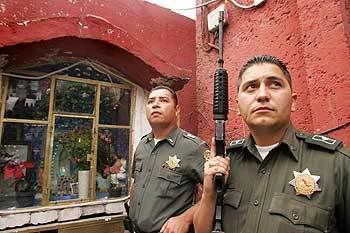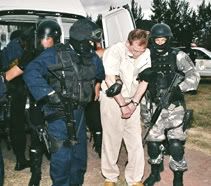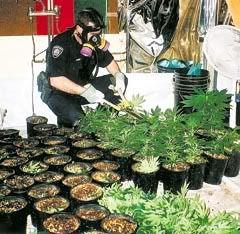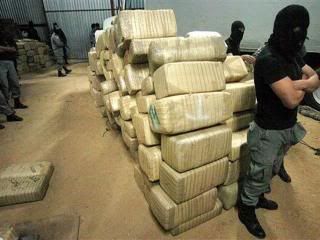

The Government and the Drug Lords: Who Rules Mexico?
http://www.worldpress.org/Americas/2763.cfm
Larry Birns, director, and Alex Sánchez, research fellow
Council on Hemispheric Affairs
April 23, 2007
In Mexico, President Felipe Calderon may be the constitutionally elected leader of the nation, but in reality, drug cartels and warlords exercise de facto authority over much of the area. During President Bush's two-day stopover in Mexico as part of his recent Latin American tour, he wasted no time in praising the accomplishments of the Calderon administration in combating drug trafficking. At a joint press conference with the Mexican leader in Merida (March 14), Bush said that: "President Calderon is taking a tough stand against organized crime and drugs, and I appreciate that." He went on to say that: "I recognize the United States has a responsibility in the fight against drugs. And one major responsibility is to encourage people to use less drugs. When there is demand, there is supply."
Now that Calderon is firmly installed as president of Mexico, after having survived Andres Manuel Lopez Obrador's strong post-electoral challenge, the new leader has shown, at least on the surface, that he is ready to tackle his country's major problems: organized crime and gross impunity. Drug trafficking overwhelmingly is the prevailing social malady throughout the country, particularly along the border with the United States. In spite of lengthy declarations by government officials in Mexico City and Washington, and their insistence that important battles are being won against drug trafficking, criminal organizations like the Tijuana cartel continue to thrive, ruling over whole sections of the Mexican countryside like sectoral feudal lords.
What's on the Agenda?
It is important to note that in his deluge of anti-drug platitudes, Bush stopped short of discussing any detailed specific initiatives to combat the drug trade. On that issue he simply stated that: "Mexico's obviously a sovereign nation, and the president, if he so chooses, like he has, will lay out an agenda where the United States can be a constructive partner." During Bush's brief visit to the country, the two presidents signed an agreement, which recognized that the fight against organized crime in Mexico could be boosted with sustained help and support from the United States. To achieve this end, Bush and Calderon agreed to continue the exchange of information between each country's law enforcement authorities – not exactly a blockbuster breakthrough. It is likely that Bush chose to avoid going into detail about his administration's initiatives to combat drug trafficking as this would inevitably raise the issue of the controversial border fence that he reluctantly has proposed to be built along the border between the two countries. Meanwhile, Calderon has declared that he and Bush "shared the need to have a safe border that will close the gates to drugs, arms, and terrorism and that will open its doors to prosperity and trade." The recently elected Mexican leader also said that his country "need[s] the collaboration and the active participation of our neighbor" to effectively control the drug trade.
Declarations made by Bush and Calderon should be seen as symbolic more than anything else. Both leaders likely realize that whatever initiatives taken to stop drug trafficking from Mexico into the United States, including the recent operations by Mexican security forces as part of Calderon's offensive on organized crime, have not succeeded to any marked degree in changing the course of the drug war in Mexico. The drug cartels continue to rule with no sure sign of their power decreasing anytime soon. Looking over a lengthy history of disappointment and failure on the part of both nations when it comes to fighting drugs, it is unlikely— save for episodic and unsustained mobilizations—that criminal activities are likely to decrease. To a great extent this is due to Mexico's organic corruption, its insistence on venality and the fact that the nation's institutions are not strong enough to stand up to threats, bribes, unremitting violence, and civic rectitude, when upward of 50 billions of tainted dollars are in play. The truth is that the anti-drug war is a cruel fiction in which too many worthy souls have given their lives, while ineffective policies, mock strategies, and puff programs as well as drug maggots (i.e., government officials) have helped make today's Mexico and the United States into a petri dish of rank societal mishaps.
Drug Trafficking
The governor of the state of Nuevo Leon (bordering the United States), Natividad Gonzalez Paras, has declared that: "Unfortunately, the drug problem has escalated significantly in the past six to seven years. It is a national problem affecting most of the country's states. It is a dispute between cartels or organizations to control locations, cities, and routes." This observation may in fact understate the current situation. The International Narcotics Control Board (I.N.C.B.) in Vienna has issued a report, stating that Mexican drug trafficking organizations and the criminal groups that control most of the organized drug traffic in the United States, particularly cocaine, marijuana, methamphetamines, and heroin have not been giving stellar performances. In 2004, American authorities seized approximately 580 tons of cannabis coming from Mexico, which provides some indication of the magnitude of the drugs currently produced and trafficked in Mexico. According to the Mexican daily La Voz de la Frontera, the I.N.C.B.'s annual report states that Mexico produced over 10,000 tons of marijuana in 2005, in contrast to the 4,500 tons produced in the United States, making Mexico the region's largest supplier of marijuana. Other reports indicate that the combined worth of the marijuana and cocaine being transported from Mexico into the United States each year has reached an estimated $50 billion. Major crossing points for these drugs are to be found in Arizona, California, and Texas.
Of the huge volume of different categories of drugs smuggled across the border into the American market, only a small amount is being seized by Mexican authorities. According to a Dec. 20 article in the Mexican newspaper El Diario, figures provided by the Mexican Defense Secretariat show that in 2006, Mexican military units had seized a paltry 13 kilograms of marijuana, no cocaine, and seven firearms — and only arrested a total of 10 suspects on drug-related crimes in the border state of Nuevo Leon. The article goes on to explain that the amount of seized marijuana peaked in 2001 with 3,912 tons, and since then has been in steady decline. In 2002 and 2003, authorities confiscated 1,106 tons and 1,616 tons of marijuana, respectively, only to see it plummet to 849 kilograms in 2004, and to 310 kilograms in 2006. Later in 2006, the number further fell to 13 kilograms. In terms of cocaine confiscations, Mexican military personnel responsible for maintaining four permanent checkpoints along the principal access highways to Ciudad Juarez had failed to confiscate even one gram of cocaine by the time the El Diario article had appeared; this was in contrast to 2001, when they had seized 18.9 kilograms of cocaine. Given these graphic statistics of underperformance, it is not hard to explain why the flow of narcotics through states like Nuevo Leon has been declining. Violence between rival cartels continues to be a daily occurrence in the affected areas. It is therefore all but incomprehensible why anti-drug authorities repeatedly claim interdictions of drug flow when in fact they are actually shrugging off their responsibilities by frequently closing their eyes to the massive drug shipments taking place. The result is a hugely damaging co-conspiracy between Bush and Calderon, with the anti-drug establishment and the criminal law system in both countries being fueled by the oceans of public funds. It now has become a fight for one's weekly salary and one's share of the immense amount of corruption that has been available by the debilitating flood of illicit payments buying public officials. The drug war goes on in spite of its relatively rare and spotty successes, because too much is at stake to end it. The moral here being pretense pays.
Some criminal organizations like the Sinaloa drug cartel have even transported some of their infrastructure to the United States, namely to the Texan city of Laredo. Here, Texas police officers are finding a growing number of safe houses being utilized by the cartel as logistical staging points to organize drug shipments and initiate armed attacks on the American side of the border. In addition, as explained in a March 2006 Dallas Morning News article, there is another reason for the movement of drug cartel operations north of the border. According to the article, there is a "soft justice" in the United States in comparison to Mexico: cartel operatives in the Laredo-Nuevo Laredo area are well aware of the fact that if they are apprehended north of the Texas-Mexico border, they likely will go to jail and be able to fight extradition to Mexico by means of their expensive American legal teams. On the other hand, if they are detained south of the border, they are more likely to be murdered in their jail cells by members of rival cartels, by Nuevo Laredo's corrupt law enforcement officials, or by Tamaulitas' state police.
Government Victories
There have been a number of important victories by Mexican authorities against drug trafficking, including seizures of illicit narcotics and the capture of high-level drug lords. These accomplishments are relatively few in number and staccato in nature, with a long hiatus often following some stunning benchmark in the anti-drug war. Therefore, it remains far from certain if the new Mexican government has managed to make a dent in drug-related crimes across the country. The most important anti-crime operation in recent months has been, according to Ciudad Victoria's El Diario, the Mexican army's seizure in late March of a 7.5-ton shipment of marijuana hidden in a trailer carrying avocadoes being shipped from Uruapan, Michoacan, apparently intended for export to the American market. Meanwhile, in Coahuila, the Mexican police and army have recommended setting up random checkpoints in La Laguna. Such an operation would include regular helicopter surveillance of rural areas around Lerdo. As a result of operations already initiated, 22 people have been detained for drug possession. Another success was the Jan. 16 arrest of drug kingpin Pedro Diaz Parada, the head of the "Diaz Parada" cartel that operates in southern Mexico. Diaz Parada is known to have shot Judge Pedro Villafuerte 33 times, (once for each year of prison to which he had been sentenced by Villafuerte).
Calderon's Winter Offensives
Anti-drug operations under Mexican President Felipe Calderon widened as a result of his decision to dispatch more federal police officers to the American-Mexican border in order to curb the violence and slash the volume of drug trafficking. As many as 17,000 troops have been deployed to areas that previously resembled the lawless regions of Somalia, with little control being exercised by the central government. The large numbers indicate the magnitude of the deployment that Calderon has been willing to carry out as part of his nationwide plans: he has sent as many as 3,000 security personnel to Baja California, particularly to the border city of Tijuana. In addition, he has sent 6,300 troops and federal police to the state of Guerrero and 9,054 personnel to Sierra Madre. This region is of particular structural importance as it is one of the centers of the expansion of drug trafficking, particularly marijuana, and includes part of the states of Chihuahua, Durango, and Sinaloa. Other reports mention that Calderon has assigned 7,000 officials to the state of Michoacan. These offensives have come with mixed but usually bloody results. The bottom line here is that Calderon will find it both expensive and distortive to the country's economy to dispatch large numbers of security personnel to only one of the country's theaters. Past experiences have been to launch showcase anti-drug offensives but see them settle down in short order.
Victories and Defeats
Last January, Mexican authorities reported that they had detained 80 suspects on drug traffic-related charges, as well as seizing hundreds of kilograms of marijuana, in major operations carried out in Michoacan. The most important detention in the latest offensives was that of a Gulf of Mexico cartel leader, Jeremias Ramirez Garcia, also known as Carne Seca (dry meat). He is believed to be a member of the Zetas — former elite Mexican commandos turned corrupt who now have been hired by the drug cartels as hit men. Overall, the government is claiming as victories the destruction of 1.500 hectares of illicit crops, like marijuana, as well as the seizure of 32 tons of the substance, along with 2.2 tons of cocaine.
For these professed achievements, much praise has been accorded to Calderon by a White House that wants to believe in the success of the anti-drug war. A Jan. 27 editorial in the Chicago Tribune amply saluted the Mexican leader, observing how "in the long, hard fight against an intractable problem, Calderon has given notice that he means business" and that he is "serious about shutting down the drug cartels and their escalating lawlessness." However, as hailed as such praise was and meant to be, it was little better than a Potemkin village similar to the language used to praise his predecessor, Vicente Fox, soon after he took office and declared a war on drugs, which soon evaporated.
At the time, American government officials and the media praised Fox for his anti-drug measures, but today the former president is cryptically portrayed as not having done nearly enough to cope with drugs. A June 16, 2005, Washington Post article by Mary Jordan and Kevin Sullivan, reported how Washington continually had praised Fox's efforts, noting that he had jailed more top cartel leaders than any Mexican president in history. However, the article concludes on perhaps a less celebratory if more accurate note by noting the conclusions of Mexican academic Jorge Chabat, whose words can be applied to both Fox and now Calderon's efforts to combat aspects of the Mexican drug problem. Chabat explains that: "the good news is that there are more capos in jail; the bad news is that it doesn't change anything … There's no change in the amount of drugs available in the street, and you have more violence. The logical question is, 'What are we doing this for?'"
Corruption + Deaths
For whatever government victories may have been achieved against organized crime and their drug cartels, there also has been plenty of retaliatory action against government officials and security forces. In the past several months there have been a growing number of assassinations, which most likely can be attributed to the drug cartels "punishing" the government. These acts have included the murder of Vidal Ivan Barraza Lujan, son of Vidal Barraza (commander of the Special Prosecutor's Office for the Investigation of Homicides Against Women), who was gunned-down as he traveled in Chihuahua. Another victim of vengeance was Abraham Eduardo Farias Martinez, a state law enforcement commander and SWAT leader, who was murdered on Feb. 28 as he headed to an anti-drug meeting. He was shot several times in the head by a hired assassin. Commander Farias Martinez's murder was the eighth homicide of an agent this year, and the 17th registered in Nuevo Leon since the beginning of 2007.
On Feb. 19, there was an attempt to assassinate Horacio Garza, a federal deputy from the Partido Revolucionario Institucional in Nuevo Laredo, and a former mayor of that town. Garza's driver was killed and Garza himself is in intensive care after their car was riddled by machine gun fire as it traveled to the airport. President Calderon has acknowledged that even he and his family have received death threats as a result of his highly publicized anti-drug trafficking offensive.
Such incidents make one wonder if the new president and his statement of avowed aggressive policing and beefing up the number of Mexican troops along the border, are making any significant headway. Perhaps the most disturbing aspect of the increasingly violent domestic violence now being recorded are the deaths of SWAT leader Martinez as well as Alejandro Dominguez. In 2005, Dominguez had been appointed the new police chief in the border city of Nuevo Laredo, mostly because he was the only person brave enough to volunteer to assume such a position. He was murdered, only hours after being sworn in, by henchmen who riddled him with automatic fire. The grim fates of the aforementioned Martinez and Dominguez should fix the idea that a state of lawlessness continues to prevail throughout Mexico, in spite of declarations to the contrary, and not even those wearing badges are especially safe.
Last year, 2,000 people were murdered as a result of drug-related crimes. Between 2000 and 2006, there were around 9,000 fatal casualties directly or indirectly resulting from drug trafficking, according to an Inter Press Service report.
Drug cartels also have become bolder in selecting their assassination targets and methods of execution. Long gone are the days when a killing was done in the middle of the night, Hollywood style, with the victim's body promptly buried in a makeshift grave in the woods. This was done in order to get rid of the evidence and to avoid any potential police investigation. Today, it is carried out much more casually; a murder victim may simply be thrown in the waters of the Rio Grande, or left to decompose in the middle of a field. Killings often occur in daytime, often by way of drive-by shootings or by attacks in popular places like malls or restaurants. The weapons used by criminals also have changed. They no longer are simply revolvers but have swelled to machine guns, grenades, and even barrels of acid (used for both torture and a body's disposal). Beheadings also have become a popular method of execution. In addition, it does not help to attempt to bring the rule of law to a country where corruption and fear of cartels have become an endemic problem within the nation's security forces.
The Mexican people believe that many police officers, government officials, and judges are on the bankroll of the different cartels, thus hindering presidential initiatives to put drug criminals behind bars. Even if a police officer does not work for the cartel but is "clean," he or she may be too afraid to act against them out of fear of a bloody reprisal. Those few brave souls that do stand up to fight the criminal gangs, like Dominguez in Nuevo Laredo, usually do not survive for long.
Is More Extradition to the U.S. an Option?
The extradition of Mexican drug lords and other top cartel bosses to the United States is becoming more and more popular among American policymakers because they distrust the ability of the Mexican criminal law system to effectively try suspects and, if found guilty, to have them sent off to the country's notoriously porous penitentiary system, where the drug lords will "escape" in a scripted manner or remain incarcerated only to see a cut in communications between them and their home cartels. An example of this was the case of Osiel Cardenas, who for four years ran his Gulf of Mexico cartel from behind the bars of a maximum-security prison in Mexico. There are reports that, while in prison, he even sponsored a "Day of the Children" party in the border town of Reynosa, complete with truckloads of toys and notes that read that they were a compliment of "jailbird Cardenas." It was only when Cardenas and other drug kingpins were handed to American authorities that their control over their organizations began to unravel.
Extradition is a complicated process that involves sovereignty and legal issues, and which comes with mixed blessings and curses. One profound example of a downside is that extradition effectively undermines the Mexican legal and penitentiary system. Essentially, individuals who commit crimes on Mexican soil and are captured by Mexican authorities, are being handed over to the justice system of another country because their own system is not viewed as effective and is vulnerable to threats and intimidation.
Calderon is likely to continue Mexico's recent policy of supporting extradition to the United States, which will certainly earn him praise and approval from Washington policymakers, even if Washington's war against drugs deserves anything less than a shrug. It was under the recently inaugurated Calderon presidency that Osiel Cardenas, along with three other drug kingpins and eleven other lesser criminals were extradited north of the border. American ambassador to Mexico Antonio O. Garza has described the extradition as a "monumental moment in our two nations' battle with the vicious drug traffickers and criminals who threaten our very way of life."
There Are Truths, and Then There Are the Real Truths
Drug trafficking is Mexico's cancer, bringing the population an indescribable number of problems, while it is barely being noticed back in the United States. The issue is not simply the thousands of deaths in drug-related incidents every year, but also the government's inability to control the drug cartels. This situation creates a profound sense of fatalism and disillusionment over the ability of elected officials and the security forces to effectively cope with crime and to honestly bring law and order to the community. Furthermore, rampant corruption and drug-related violence discourages foreign investment and prevents development — two issues that Mexico needs to resolve.
Even if Mexican authorities were able to occasionally apprehend major drug kingpins, who were later extradited to American prisons, this situation would only leave a power vacuum within the cartel in which 10 different drug "lieutenants" would try to fill. Ultimately, it is a near certainty that this would trigger intra-gang violence as drug lieutenants launch internecine combat in a personal quest for power, which in the process will certainly claim many innocent civilian lives. Just this past March 29-30, gunmen killed two Mexican police officers and six civilians in less than 48 hours in the city of Monterrey in Nuevo Leon. Apparently, the deaths came as a result of inter-gang warfare over turf between the Sinaloa and the Gulf of Mexico cartels. Over 200 rounds were shot at a group of six men, killing three and injuring others, who apparently had no connection to the drug trade and were simply standing outside the wrong house at the wrong time.
The current plan to combat drug trafficking in Mexico is simply not working. Unfortunately, no other viable alternative solution exists with the exception of the further deployment of the Mexican army to lawless regions and the subsequent extradition of drug criminals to the United States. While some praise can be given to Fox and Calderon for wholeheartedly taking measures to curb drug trafficking and violence in the nation, in reality it has been more a matter of appearance than a hard and lasting fact. In this respect, Calderon is already on the same path that Fox eventually took: much thunder but little lightening.



No answer as drug killers cut, paste and delete
http://australianit.news.com.au/articles/0,7204,21608278%5E15306%5E%5Enbv%5E,00.html
DRUG traffickers are waging a highly effective publicity campaign in Mexico that began with a chilling show of brutality in Acapulco: two police officers' heads, streaming with blood, were stuck on spikes with a fluorescent sign.
So that you learn to respect," it read in thick black letters.
The spectacle last year in the Pacific resort set off a ghoulish trend among the drug lords battling for billion-dollar smuggling routes into the US. They've since left a trail of bodies and bloody notes across Mexico, with a goal of spreading fear - dread so deep that rivals, police, witnesses and President Felipe Calderon won't dare cross them.
Steve Robertson, a US Drug Enforcement Agency agent who worked for 17 years on the US-Mexico border, said the publicity campaign is just the latest tactic traffickers are using to control their turf. "The drug trafficking organisations are a business, and like any successful business, they are using the latest toys, like email, cell phones or BlackBerries."
Regular citizens were left out of this calculation as organised crime groups settled scores between themselves.
No longer. The drug gangs now publish newspaper ads, and tack threatening notes to corpses with ice picks or tape them to garbage bags filled with body parts for public display.
They're even using the internet, posting a video on YouTube that showed the apparent beheading of an alleged hitman.
"Before long, they're going to have their own TV program, Narconews, where they drag out their dead for show," drug expert Jorge Chabat grimaced.
Drug killings using corpses as message boards have been carried out in a dozen Mexican states in the past year - an indication, experts say, that Mexico's rival Gulf and Sinaloa cartels hope they can frighten the population to the point that Calderon will retreat from his nationwide military crackdown.
In many areas, it's working: Police are resigning in record numbers, newspapers are censoring themselves and witnesses rarely expose themselves to a justice system thought inefficient and corrupt.
"Without a doubt, this is part of a strategy by organised crime to terrorise the population and destabilise the government," says Nuevo Leon deputy state attorney-general Aldo Fasci Zuazua, whose state bordering Texas has seen nearly three dozen drug-related killings since January, including one threatening the top state prosecutor with a message on an ice-picked corpse. Drug lords have long used killings and torture tactics to communicate with rival gangs and police.
The former Amado Fuentes Carrillo cartel in Ciudad Juarez cut off the fingers of informers and shove them down their throats. Others who crossed drug lords are given a "Colombian necktie", in which the victims' tongues are pulled through their slashed throats.
Now such messages go straight to the public. In Calderon's home state of Michoacan, The Family, a shadowy group believed allied with the Gulf cartel, took out a newspaper ad saying it wanted to stop kidnapping, robbery and the sale of methamphetamines in the state.
The ad blamed violence on a rival gang and depicted The Family as entrepreneurs trying to mind their own business.
"Perhaps at this time people don't understand us, but we know that in the most affected regions, they understand our actions," it said.
"People who work at any decent activity have no reason to worry."
The group delivered a similar message in much more grisly fashion last year, rolling five heads across a dance floor in a Michoacan town with a note that said The Family "doesn't kill innocent people, only those who deserve to die. Everyone knows that."
One of the boldest displays yet was a video posted on YouTube this month.
It showed a man in his underwear, tied to a chair with a "Z" written on his chest -- an apparent reference to the Zetas, former military operatives who now are Gulf cartel hitmen.
The video, which was picked up by newspapers across the country, called on Mexicans to "do something for your country, kill a Zeta".
Someone off-screen interrogates the man about the February 6 killing of five Acapulco police officers and two secretaries, punching him repeatedly until he says he participated in the attacks.
Then he's shown being strangled by using metal rods to twist a cord around his neck. The video then shows his headless body.
Anyone can post a video on YouTube; there was no way to confirm the video's authenticity or determine who made it. Police have not found a body.
Peace: before the war on Drugs
http://jim.com/drug_peace.htm

In turn-of-the century America, opium, morphine, heroin, cocaine, and marijuana were subject to few restrictions. Popular tonics such as Vin Mariani and Coca-Cola and its competitors were laced with cocaine, and hundreds of medicines—Mrs. Winslow's Soothing Syrup may have been the most famous— contained psychoactive drugs. Millions, perhaps tens of millions of Americans, took opiates and cocaine. David Courtwright estimates that during the 1890s as many as one-third of a million Americans were opiate addicts, but most of them were ordinary people who would today be described as occasional users.
Careful analysis of that era—when the very drugs that we most fear were sidely and cheaply available throughout the country—provides a telling antidote to our nightmare legalization scenarios. For one thing. despite the virtual absence of any controls on availability, the proportion of Americans addicted to opiates was only two or three times greater than today. For another, the typical addict was not a young black ghetto resident but a middle-aged white Southern woman or a West Coast Chinese immigrant. The violence, death, disease, and crime that we today associate with drug use barely existed, and many medical authorities regarded opiate addiction as far less destructive than alcoholism (some doctors even prescribed the former as treatment for the latter). Many opiate addicts, perhaps most, managed to lead relatively normal lives and kept their addictions secret even from close friends and relatives. That they were able to do so was largely a function of the legal status of their drug use.
But even more reassuring is the fact that the major causes of opiate addiction then simply do not exist now. Late nineteenth-century Americans became addicts principally at the hands of physicians who lacked modern medicines and were unaware of the addictive potential of the drugs they prescribed. Doctors in the 1860s and 1870s saw morphine injections as a virtual panacea, and many Americans turned to opiates to alleviate their aches and pains without going through doctors at all. But as medicine advanced, the levels of both doctor- and self-induced addiction declined markedly.
On June 27, 1991, the Supreme Court upheld, by a vote of five to four, a Michigan statute that imposed a mandatory sentence of life without possibility of parole for anyone convicted of possession of more than 650 grams (about 1.5 pounds) of cocaine. In other words, an activity that was entirely legal at the turn of the century, and that poses a danger to society roughly comparable to that posed by the sale of alcohol and tobacco, is today treated the same as first-degree murder
Precedents for each of these penalties scarcely exist in American history. The restoration of criminal forfeiture of property—rejected by the Founding Fathers because of its association with the evils of English rule—could not have found its way back into American law but for the popular desire to give substance to the rhetorical war on drugs.
History holds one final lesson for those who cannot imagine any future beyond drug prohibition. Until well into the 1920s most Americans regarded Prohibition as a permanent fact of life. As late as 1930 Sen. Morris Shepard of Texas, who had coauthored the Prohibition Amendment, confidently asserted: "There is as much chance of repealing the Eighteenth Amendment as there is for a humming-bird to fly to the planet Mars with the Washington Monument tied to its tail."
History reminds us that things can and do change, that what seems inconceivable today can seem entirely normal, and even inevitable, a few years hence. So it was with Prohibition, and so it is—and will be—both with drug prohibition and the ever-changing nature of drug use in America.

Penn and Teller's Bullsh*t - The War on Drugs Pt 1
Penn and Teller's Bullsh*t - The War on Drugs Pt. 2
Penn and Teller's Bullsh*t - The War on Drugs Pt. 3













![Brotherhood" (2006) [TV-Series]](http://photos1.blogger.com/x/blogger2/1421/379621144723082/211/z/425926/gse_multipart33129.jpg)







No comments:
Post a Comment